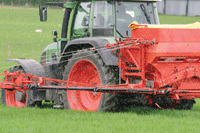Nitrogen fertiliser choice must allow for urea volatility

Do your sums carefully when thinking of substituting urea (46% N) for ammonium nitrate (AN) (typically 34.5% N) as your nitrogen fertiliser, urges ADAS.
Given recent wide swings in prices and fluctuating differentials between the two main sources of artificial N, those calculations are more important than usual, says senior soil scientist Brian Chambers.
Although savings from switching to urea may seem attractive, practical points need considering.
Despite continued claims to the contrary (see panel), significantly more of the N applied as urea rather than AN may be lost to the air as it volatises.
That was confirmed in 28 field experiments for DEFRA between 2002 and 2005, says Prof Chambers. “The work measured the agronomic efficiency of urea and AN using wind tunnels to assess their ammonia emissions.”
Average losses
It found average N losses, as ammonia gas, were only 2% from AN but 22% from urea used on arable land – and even more when applied to grassland. At their worst arable losses peaked at 43%.
“Before then there was a belief that ammonia emissions were a problem only on sandy or shallow chalk soils. This recent work shows soil type is largely irrelevant.
“The emissions related well to decreases in crop N offtake. In many cases we didn’t see that reflected in yield, but the overall conclusion was that urea was 20% less efficient [in meeting crop needs] than AN.”
Results
Independent consultant Ian Richards of Ecopt says the latest findings back results from work as far back as the 1950s. “It’s not straightforward for any single instance and it’s hard to make a clear statement about the agronomic impact [of switching N fertiliser] without knowing all the prevailing factors.
“But over a large number of fields and crops, on average the N from urea is less effective.
“It’s all a question of risk,” says Mr Richards. “The average 20% N loss typically translates to a 3% yield loss, depending on where you are on the dose response curve. That’s extremely important to growers but something they won’t see in the field.
“It’s very difficult to spot even a 10% yield difference between adjacent trials plots.”
Much depends on field conditions, says GrowHow’s Allison Grundy.
Effective
Given moist soils, temperatures below 10C and light rain straight after urea applications can be as effective as AN – and occasionally even more so. “But that’s unusual – only one year in 10,” she says.
Applied when soils are wet and temperatures moderate, perhaps seven years in 10, urea is only 80-90% as effective. And the rest of the time, when the land is light, either very wet or very dry, and the weather warm or windy, it may be only half as effective.
Choosing urea is much riskier, says Masstock’s crop nutrition specialist David Langton.
The ADAS research suggested that on average 20% more urea would be required to maintain yield and quality – but that’s only an average, he points out. Applied under ideal conditions the N losses might be as low as 2%.
“In these circumstances you’d be over-fertilising the crop so increasing the chances of lodging and yield loss and putting the environment at risk from leaching.”
However, if conditions meant the lost N reached 43%, as in the arable trials, the crop would clearly have been left short of nitrogen, jeopardising yield and quality, explains Mr Langton.
Careful
Urea can produce good results provided conditions are suitable, with rain to wash it in with two or three days of application, acknowledges Yara’s Mark Tucker. But growers compensating for potential volatilisation should be careful not to breach the new Nitrate Vulnerable Zones restriction, he warns.
“If the recommendation is for 20% more than for AN make sure you don’t go above your N max limit.
“And if you’ve previously used an AN product with sulphur but bought straight urea this time, you’ll need to remember to supply the S some other way.”
With the N in urea, depending on when it was bought being up to 40% cheaper than in AN, it’s understandable that growers are taking a fresh look at it, says Prof Chambers.
“But go for granular urea rather than prills.” Prills are less dense and cannot be satisfactorily spread wider than 12m unless using pneumatic equipment, he explains.
Another point to bear in mind is that farmer experience shows urea is slower acting than AN, says Mr Langton. “That’s because it has to go through biological processes to become available.
Velcourt’s technical director Keith Norman agrees. “It’s not a direct replacement for AN. You need to bring application timings forward by a week to 10 days.”
- LINCOLNSHIRE FARM SWITCH
 Former Farmers Weekly Barometer farmer Ben Atkinson has turned to urea for all his N dressings on his Lincolnshire land this season.
Former Farmers Weekly Barometer farmer Ben Atkinson has turned to urea for all his N dressings on his Lincolnshire land this season.
“The temptation purely on price was too great. We’ve traditionally used urea/AN liquid and always got on very well with it. But the volatility of the market is horrendous. And even though I probably jumped in too early we’ve made substantial savings – over 25% – by going for granular urea.
“I am slightly concerned about the accuracy of spreading compared with using liquid over our 32m tramlines, but our Amazone spreader is claimed to be able to handle it at that width. We’ll just have to be a bit more careful in picking our days.”
Like this year’s Farmers Weekly Arable Farmer of the Year, Andrew Ward who claims never to have seen yield losses from using urea instead of AN, Mr Atkinson is not unduly worried about its supposed volatility.
“I believe it’s about 5% and we’ll make an allowance on that basis. But that’s really only when conditions are hot and dry – and when are we going to see those again? The volatility argument is mainly being banded about by people trying to sell AN.”
- Urea N losses ‘nominal’
Lincolnshire importer Thomas Bell, which supplies both AN and urea, plays down the latter’s volatility.
In most application conditions and soil types, any atmospheric N loss is nominal and no more than with AN, its website states.
“The only conditions on any significance where nitrogen loss may be measurable are on very sandy or light chalky soils, where urea is top-dressed onto moist soils and followed by more than two weeks of warm and dry weather.”

